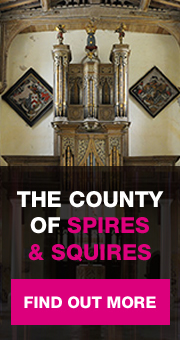Churches for a purpose:
-
Top PickThe church is set at the far end of the village and from here you get wonderful views over the Welland valley. The building itself represents a splendid silhouette with a splendid tower...
-
Top PickAll Saints and Saint James Church stands on an imposing site with the east wall of the chancel facing Hall Yard. The present rectory is a fine Georgian building which was formerly a mill...
-
Top PickWhilst the tower is medieval the church was so re built in the 17th and 18th century and that is it’s overriding appearance. The vestry though was added by Bodley, 1879. Internally...
-
Top PickAt All Saints you encounter a “Wren“ city church in the provinces of the highest quality. In 1675 Northampton’s principal medieval church was burnt down leaving just it...
-
Top PickNow re-opened following extensive Roof Repair & Restoration works. For centuries this was an estate church to a succession of families, the Burnabys, Clerkes, and then the Edens, later...
-
Top PickA distinctive building with a stone striped tower and soaring spire. Medieval in origin, with regular gothic arches and wide well lit aisles and side chapels, today it is a fascinating...
-
Top PickOne of the few late-19th century Catholic churches in Northants: Grade II listed. “The church is distinguished by some highly original details, and has a largely intact and lavishly...
-
Top PickA thrilling experience: Sir Ninian Comper’s masterpiece built between 1908 and 1930. It is a free essay in the gothic style fearlessly mixed with classical appropriations. Externally...
-
A richly rewarding church, both warm and welcoming in the smart northern suburb of Northampton. Here the local population did well to rebuild their church after a great storm destroyed...
-
This archetypal medieval church is set in the heart of the village. It abuts a clearly later square tower (1633) topped by a good spire and on the south side a chapel, refashioned in 1621...
-
A 14th/15th century building with very good furnishings. 15th century Rood Screen and pews,17th century three decker pulpit, 18th century box pews. The stained glass dates from the mid...
-
The village of Barnwell has two churches. The parish church of St Andrews and the remains of All Saints. The latter was largely demolished in 1825 but its chancel was maintained as it had...
-
This is a church for those who enjoy an architectural jigsaw. The exterior gives a clue to the complexity of the game. The nave, chancel and dominant central tower are Norman but given...
-
This sumptuous tractarian church was erected in 1848 through the munificence of the Watts-Russell family. it was designed by John Macduff Derick and was further enhanced by Sir Ninian Comper...
-
This pleasantly remote church stands at the end of a short walk shaded by ancient trees, with the vestiges of the 18th century mansion of the O’Brien family to your left. Beyond its...
-
A Norman church largely rebuilt in the fourteenth century. Still with a good Norman font with intertwined monsters, fish and seemingly incongruously a cross. A medallion containing the...
-
A 13th century church considerably extended in the 14th century in the perpendicular style. Restored in 1870 by Slater and Carpenter with pew ends carved by the then incumbent, the Revd...
-
Sitting on top of the hill, just across the road from Canons Ashby House, this church is also looked after by the National Trust. It is a fragment of the west end of the nave of the Augustinian...
-
The Church which lies adjacent to the House but which it antedates by some 400 years. It must have been used by the Bishops of Coventry whose seat this was before the advent of the Comptons...
-
One of the most rewarding of the county’s churches to visit all be it that it is best to arrive accompanied by a passenger otherwise you have to deal with the gated road from the...
-
The tall Saxon tower is the oldest part of this church, which was rebuilt in the 16th century and then again, rather enthusiastically, in the mid 19th century. The latter was undertaken...
-
Originally a Norman church (west door) with a wide tall chancel added in 1338 when a college here was founded by John Giffard, Canon of York. It seems to have been the largest private...
-
Externally a particularly handsome medieval church with full square tower with fine double bell openings – all dating from circa 1300. The interior therefore comes as a surprise being...
-
Well done if you have found it! The church is tucked away in the estate village that lies behind Courteenhall Hall. If that was not enough, the M1 sealed its remoteness cutting it off from...
-
St Andrew’s Church dates from the time of King Henry II (1154 -89). Its Norman arcade and additions from every subsequent medieval century, give this church a rich and varied history...
-
The north west part of the county has a group of large well built villages that have the quality of an 18th century town. Crick is amongst these with a very pleasant variety of buildings...
-
A quintessential country church standing alongside the village street from where you can look out across countryside that rolls away to the southern county border. Whilst the exterior...
-
Like the Royal Mausoleum at Frogmore St Peter’s is a magnificent mid 19th century memorial church: here to the memory of that famous Crimean soldier General James Brudenell, 7th Earl...
-
Church rebuilt in Decorated Gothick style by the architect John Wing the younger, for Sir John Palmer Bt. in 1788. Broad T plan with Palmer memorial chapel and vestry in the arms of the...
-
The building is early 14th century with a slightly later tower and then restored by Lord Alwyne Compton who on this occasion employed William Slater. Having visited Castle Ashby Lord Alwyne...
-
St Mary’s Church is all that remains of the Medieval village of Easton Neston when, following the enclosure of the land, the village was transferred to Hulcote. The church stands...
-
A fine looking medieval church, built between 1200 and 1340, with a prominent interestingly decorated west tower. You enter through the late medieval porch which is unusually inscribed...
-
However you reach it, Edgcote feels removed from daily life – out of time. Down a lane you encounter the balanced composition of church & rectory, Manor House, stables &...
-
It will be primarily the late 19th century / 20th century stained glass that will draw you to this small medieval church at the centre of this handsome ironstone village. The church itself...
-
A romantic church that stands alone, shorn of it’s former medieval village, looking out across the Capability Brown landscape of 1760’s toward Fawsley Hall, the seat of the...
-
Don’t give up on your search for this church. It is well worth the effort. You will find it at the far west end of the village overlooking countryside. A large building constructed...
-
This remote church at the most southern point of the county is beguilingly set at the end of a long tree lined lane which is well indicated by a brown sign off the main Northampton / Milton...
-
An enchanting stone-built village set in beautiful countryside surrounding Boughton House, a stately home and estate of 11,000 acres that is one of the seats of the Duke of Buccleuch....
-
A royal village indelibly linked with Edward lV's Queen, Elizabeth Woodville and with Charles ll who gave this crown property to his natural son Henry FitzRoy, Duke of Grafton. In the...
-
A royal village indelibly linked with Edward lV‘s Queen, Elizabeth Woodville and with Charles ll, who gave this crown property to his natural son Henry FitzRoy, Duke of Grafton. ...
-
The church dates from circa 1300 but it is the intervention of the Spencer family of nearby Althorp that transform the Medieval building. Sir John Spencer (d. 1522) rebuilt the chancel...
-
The church stands some way from the village, isolated but not austere. St Peter and St Paul dates back to the early years of the 14th century although the narrow aisles were added one hundred...
-
A wonderful juxtaposition of medieval England and the advance of 19th century technology. This towered and spired church, built in both limestone and ironstone, lies adjacent to the great...
-
The medieval church has a fine west tower circa 1500. Internally restored by William Slater in 1859/60 (he was born in the village) and later the chancel more elaborately by F. Butler with...
-
The church owes its grandeur to the fact that the town was, and still is part of the Duchy of Lancaster. The fascinating ancillary buildings – Bede House, the college and the school...
-
The name Holdenby dates back to the time of Scandinavian settlements and derives from the personal name ‘Halfdan’ (or Haldane) and the word ‘by’ meaning farm. The...
-
Despite being in the busy Nene Valley between Wellingborough and Thrapston, Irthlingborough church seen from the far side of the river retains a timeless and surprisingly isolated quality...
-
The medieval church here was re built in 1874 for Richard Naylor to designs by J.K. Colling which resulted in the most lavish 19th century church interiors in Northamptonshire. The architect...
-
This noble medieval building remains the dominant architectural feature of this ancient market town. It’s handsome tower and tall spire is strikingly visible especially from the south...
-
You can spot this church from miles away although it lies in the Cherwell Valley. Its spire, dating from circa 1370, is both the most beautiful and one of the tallest in the county (60...
-
Of early medieval origin but almost entirely rebuilt during 15th century and an especially fine example of Perpendicular architecture, most notably its splendid lantern tower. From the...
-
St Peters is on the highest point of the village believed to have been the site of worship since pagan times. The present building dates from 1100 and has been extended over the...
-
A Church of 17th century surprises during the reign of Charles I. The rector here was Charles Chauncey who, falling foul of archbishop Laud, left for America to become President of Harvard...
-
The creation of this outstanding late Victorian gothic church was made possible by it’s patron the local brewer Pickering Phipps, the local architect Matthew Henry Holding and it&...
-
The church is now looked after by The Churches Conservation Trust. One of the best Norman Churches in Britain. It’s sophistication in design and ornament is a reflection of the national...
-
A large 14th /15th century church with a slightly earlier tower impressively placed at the edge of the village near the former Norton Hall, formerly a seat of the Knightley family of Fawsley...
-
The adjectives used to describe this church are consistently ‘beautiful and elegant’ and so it is. Whilst there is evidence of its earlier incarnation – it was founded...
-
This fine church, set in the tiny hamlet of Passenham, dates back to the 13th /14th century but was largely rebuilt in the early 17th – upper stages of the tower, the nave roof, and...
-
Two distinct reasons for coming here: the rare medieval wooden effigies; and the association with the great non-conformist missionary William Carey (1761 – 1834). A well-positioned...
-
This remote church, attached to the small hamlet of Plumpton which lies between Weedon Lois and Blakesley, was rebuilt by the local significant landowner, Jesus College Oxford in the 1820...
-
This church has strong American associations as during the Second World War some 6,000 men and women of the 351st Heavy Bombardment Group Eight, United States Army Airforce, were stationed...
-
Preston – the ‘priests’ farm’ was also known formerly as Preston juxta Northampton and Preston Juxta Piddington. From about 1720 the current suffix was adopted,...
-
The medieval church was destroyed during the siege of Rockingham Castle in the civil war as was the village that then surrounded it. The present building is on the same site and largely...
-
There are two reasons for visiting Rothwell - The Church of the Holy Trinity and the Market House. The church was large, even in Norman times and grew from the 14th century onwards. It...
-
One of the outstanding late medieval churches in the county. Whilst there remains evidence of an earlier church what you largely see today dates from the early 1400’s. On the outside...
-
The church stands at the highest point of the village and dates from the 12th / 13th century. It was largely built under the auspices of the Lucy family whose crest of three pike can be...
-
The tower is well buttressed and unusually decorated. The first is accounted for by the susceptibility of the earth to subside on account of the Romans extracting iron stone from the vicinity...
-
This particularly fine church was built during the first half of the 14th century and there have been little alterations since then. It gives a very good impression of English gothic architecture...
-
Set in the gardens of Steane Park this is a rare church built in the gothic style in 1620. Whereas Tom Tower in Oxford can be seen as Wren’s essay in Gothic Revival, Steane is one...
-
The decline in the parish population from the late medieval period led to the demolition of the early parish church in 1722. In its place a fine early Georgian church was erected to the...
-
A handsome, light and well-proportioned church built in local limestone. Constructed circa 1250 -1300 and very likely restored by E.W. Law (1850-1872) and again by J.C. Traylen (1890/1)...
-
Set in the former estate village for nearby Lilford Hall, this 13th century church with its fine tower and spire was restored and extended by Lord Lilford and his architect, William Slater...
-
Externally it is the late 15th century tower that grabs one’s attention. It was built by Lord Lovel, Lord Chamberlain to Richard lll. It is by far and away one of the most impressive...
-
Here is a large town church that speaks of the 15th century in 1483 Edward IV the husband of Elizabeth Woodville of nearby Grafton Regis, gave a large grant of stone from the royal quarries...
-
In the mid 18th century the medieval church was radically altered as it took on the mantle of the mausoleum of the Dukes of Montagu of nearby Boughton House. This had only slight effect...
-
The church is a sole survivor of a complex of medieval and Jacobean buildings which constituted first Warkworth Castle and from the 17th century a large Jacobean house. In 1805 the non...
-
It’s the nave’s roof. When you would expect to see soaring stone vaults here you find a late gothic wooden roof instead (albeit restored by G.G. Scott in 1876). It’s like...
-
A remarkably fine perpendicular church built to the orders of one man, Anthony Catesby (1500 – 1554) of the significant Northamptonshire Catholic family whose main seat was at Ashby...
Your login details have been used by another user or machine. Login details can only be used once at any one time so you have therefore automatically been logged out. Please contact your sites administrator if you believe this other user or machine has unauthorised access.








